|
|
|
Sort Order |
|
|
|
Items / Page
|
|
|
|
|
|
|
| Srl | Item |
| 1 |
ID:
141786
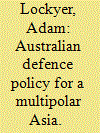

|
|
|
|
|
| Summary/Abstract |
There is a growing consensus among defence planners that Australia is in need of a new defence policy that better suits the strategic realties of an emerging multipolar Asia. After assessing the implications of shifting regional power balances for Australia, this article advances the argument that Australia should redirect its attention back to its immediate north: the “Indo-Pacific Arc”. Indonesia, Singapore and Malaysia have always been vitally important to Australia’s long-term security and, being the gateway between the Indian and Pacific oceans, their strategic value is set to dramatically increase in the multipolar Asia. Finally, this article develops the case for Australia to partner with its neighbours to stem the political and military influence of outside powers into the Indo-Pacific Arc.
|
|
|
|
|
|
|
|
|
|
|
|
|
|
|
|
| 2 |
ID:
096862
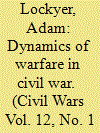

|
|
|
|
|
| Publication |
2010.
|
| Summary/Abstract |
This article explains theoretically, and demonstrates empirically, the instrumental role of the balance of capabilities in shaping the form of warfare that develops in civil wars. It contends that the current common practice of labelling civil wars as either 'guerrilla' or 'conventional' (which is usually meant to accurately characterise the type of warfare throughout an entire civil war) is unable to fully encapsulate the dynamic nature of warfare in civil war. It is instead argued that the form of warfare frequently varies significantly across time and space in a single conflict. This article is divided into three sections. Section one examines recent advances in the understanding of warfare in civil wars. It identifies three categories of warfare in civil war: conventional, guerrilla and irregular. Section two builds on previous studies to develop the concept of the balance of capabilities. Finally, the article illustrates these theoretical insights through a discussion of the American and Somali Civil Wars.
|
|
|
|
|
|
|
|
|
|
|
|
|
|
|
|
| 3 |
ID:
109960
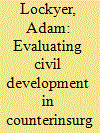

|
|
|
|
|
| Publication |
2012.
|
| Summary/Abstract |
It is a widely held belief that civil development programs play a central role in any counterinsurgency campaign. It is assumed that civil development assistance is key to 'winning the hearts and minds' of the civilian population, which, in turn, is crucial for victory. However, there is currently little evidence to support this belief. This article begins by analysing the different methods that have been used in Afghanistan in order to evaluate the effectiveness of civil development programs since 2001. It finds that these methods have severe limitations. Indeed, based solely upon current methods of evaluation, we have no reliable evidence whether civil development programs are actively improving security, having no impact or making matters worse. As such, this article makes the case for a field experiment approach to be adopted in Afghanistan. It argues that field experiments are the most powerful methodology currently available to social scientists for making causal inferences and, by making minor changes to the way in which civil development is distributed, we can vastly improve our understanding of the relationship between aid and security.
|
|
|
|
|
|
|
|
|
|
|
|
|
|
|
|
| 4 |
ID:
108505
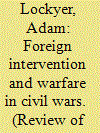

|
|
|
|
|
| Publication |
2011.
|
| Summary/Abstract |
This article explains how foreign assistance to one or both sides in a civil war influences the dynamics of the conflict. It submits that external assistance has the potential of affecting the military capabilities available to the belligerents. It then argues that the balance of those capabilities impacts significantly on whether the warfare in a civil war assumes a conventional, guerrilla or irregular form. These theoretical assertions are tested against the case of the Angolan Civil War. It is shown that during that war, variations in the form of warfare correlated closely to the type, degree, and direction of foreign intervention given to each of the belligerents.
|
|
|
|
|
|
|
|
|
|
|
|
|
|
|
|
| 5 |
ID:
114157


|
|
|
|
|
| Publication |
2012.
|
| Summary/Abstract |
This article argues that opposition political parties can play an important role in determining when and how a democracy exits a small war. Recent theoretical and empirical research on small wars has further uncovered the restrictions and constraints that democratic societies place on their government's war strategies. However, the mechanisms through which public opinion constrains and pressures government strategies have received relatively less academic attention. This article examines the role that opposition political parties play in providing an avenue through which society can shape foreign policy-namely, the exiting from small wars. It argues that opposition political parties can be instrumental in determining democracies' war termination in three ways: through 'elite cuing', applying electoral pressure, or winning an election and assuming government.
|
|
|
|
|
|
|
|
|
|
|
|
|
|
|
|
| 6 |
ID:
121243
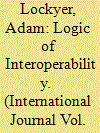

|
|
|
|
|
| Publication |
2013.
|
| Summary/Abstract |
Since 1918, Australia has joined the United States in every one of its major
conflicts: World War Two, Korea, Vietnam, the Persian Gulf, Somalia,
Afghanistan, and Iraq. Australia's enduring commitment to the alliance has
led to a renewed focus on joint operations. The new maxim within Australian
defence circles is "interoperability." Interoperability with the US military
has become the keystone phrase for many issues relating to Australia's
procurement, strategy, and doctrine. Yet the other phrase used equally as
often is "self-reliance." Australian strategic planners simultaneously view the
US as an indispensable and unreliable ally. Although Australia has always
been at America's side, Australia was disappointed by the unenthusiastic
response of the US to the 1999 East Timor crisis. As such, the underlining
logic of interoperability is to hedge between dependence and self-reliance.
|
|
|
|
|
|
|
|
|
|
|
|
|
|
|
|
| 7 |
ID:
168380


|
|
|
|
|
| Summary/Abstract |
Given current emissions trends an increase in global temperatures in excess of 2°C is highly likely in the coming century. In this context, it seems increasingly probable that states may consider solar geoengineering as a stop-gap climate response. Solar geoengineering refers to measures that aim to alleviate some measure of global warming by intentionally increasing the amount of the sun’s energy that is reflected into space. Currently the two most discussed solar geoengineering techniques involve either marine cloud brightening or dispersing aerosols in the stratosphere. These techniques could be relatively inexpensive, are within the technological capacities (after a brief period of development) of technologically-advanced countries, and could have an almost immediate impact on temperatures. Yet, while solar geoengineering might potentially be utilised to manage some climate-linked security threats, it itself would create new security challenges. Consequently, this paper explores potential international security implications for Australia if a regional state, or group of states, initiates a solar geoengineering program. We conclude that since solar geoengineering is unlikely to become a first-order international issue, disputation over solar geoengineering will likely reflect, or act as a proxy for, wider patterns of state interaction. However, scenarios in which China and the United States take different positions, or in which there are divisions among regional powers, such as Indonesia, Malaysia, India and Singapore would pose the greatest threat to Australia’s national security.
|
|
|
|
|
|
|
|
|
|
|
|
|
|
|
|
|
|
|
|
|